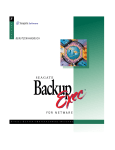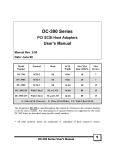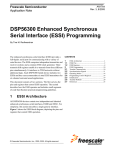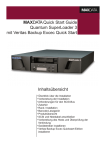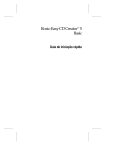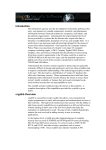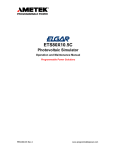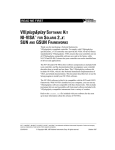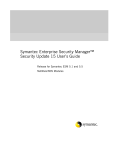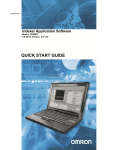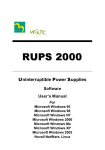Download FOR NETWARE
Transcript
7 v e r s i o n TM F O R N E T WA R E Tested and Approved CD Install Guide Page 1 Monday, October 28, 1996 3:14 PM Introduction This guide is designed to help you install Backup Exec for NetWare from the Backup Exec Installation CD. It is intended for administrators familiar with installing NLMs on NetWare 3 and 4 fileservers. This guide provides a condensed version of the installation topics covered in the Administrator’s Manual. About Backup Exec’s On-line Documentation On-line documentation, marketing literature, and other information are included on the Backup Exec installation CD. These documents can be displayed with the Adobe Acrobat for Windows reader which is included on the CD. To view an on-line document: 1. Insert the CD into a Windows workstation’s CD-ROM drive, or the CD mounted as a volume on the file server. 2. The manual files and Acrobat Reader are located in the DOCS directory on the CD (e.g., \netware\docs\eng). 3. Install the Adobe Acrobat reader software on the workstation by running acroread.exe. 1 CD Install Guide Page 2 Monday, October 28, 1996 3:14 PM 4. After installing Adobe Acrobat, open the manual you want to view by double clicking the icon located in the \Netware\Docs\Eng directory on the CD. Backup Exec’s Administrator (Admin.pdf) and Workstation Client (Client.pdf) manuals are included. You can also open the manual files while running Adobe Acrobat from the File\Open menu. In addition to Adobe Acrobat’s powerful search tools, you can use the manuals’ hypertext table of contents and index sections to quickly find information. If you want to copy the on-line documentation to your server, specify to do so during Backup Exec’s installation or use the DOCS2SVR command. For example, type: d:\netware\DOCS2svr w:\BKUPEXEC\DOCS Installation Overview Backup Exec’s installation is a five-step process: 2 1. Install the tape hardware (controller and tape drive) in the backup server. 2. Install Backup Exec on the backup server. During installation, files required for configuring workstation clients and agents are also copied to the backup server. CD Install Guide Page 3 Monday, October 28, 1996 3:14 PM 3. Upgrade other NetWare fileservers that are to have backup and restore operations performed on them by Backup Exec (applies only to Enterprise Edition). 4. (Optional) Modify the AUTOEXEC.NCF file with the addition of the BESTART.NCF file. (The BESTART.NCF file loads the Job Manager and the resources it requires.) 5. Reboot the server. Before you proceed with the installation, please make sure that your server and workstations meet Backup Exec’s minimum system requirements and take a moment to read the pre-installation notes included in this guide. Installation Requirements Servers and workstations on your network must meet the following requirements to run Backup Exec. Module Requirements NetWare ◆ Novell NetWare 3.11 or 4.01 or later. 2.5 MB RAM over server requirements. 14 MB disk space. ◆ Compatible tape device and controller. (A compatibility listing can be found in the HARDWARE.DOC file located in the \Netware directory on the Installation CD.) 3 CD Install Guide Page 4 Monday, October 28, 1996 3:14 PM Module Requirements Windows client and agent ◆ DOS client and agent ◆ ◆ ◆ OS/2 client and agent OS/2 2.0, 2.1, WARP 3.0, and WARP Connect, LAN Server 2 and 4.2 ◆ .5 MB RAM, 4.0 MB disk space (client) .25 MB disk space (agent) Windows NT agent ◆ ◆ UNIX agent ◆ Macintosh agent ◆ System 7.x using the ADSP (AppleTalk) interface Oracle for NetWare Agent** ◆ ◆ Oracle for NetWare 7.0 and 7.1 1.5 MB RAM, .65 MB disk space (agent) Microsoft Windows 3.1, Windows for Workgroups 3.11 or Windows 95 ◆ 700 KB RAM, 2.5 MB disk space (client) 35 KB RAM*, .20 MB disk space (agent) MS-DOS 5.0 and above Novell DOS 7, PC DOS 6.3 and 7.0 580 KB RAM, 1.5 MB disk space (client) 35 KB RAM*, .20 MB disk space (agent) ◆ Windows NT 3.1, 3.5 and 4.0 .20 MB disk space (agent) SCO UNIX 3.2, Interactive 3.2, SUN OS 4.1x, UnixWare 1.x, 2.x, SUN Solaris 2.3, HP/UX 9.x ◆ .15 MB disk space (agent) *Can be loaded into high memory or unloaded ** Requires optional agent module 4 CD Install Guide Page 5 Monday, October 28, 1996 3:14 PM Pre-Installation Notes For a trouble-free installation, please take a moment to read the following notes: • Make sure your controller and tape device are listed in Backup Exec’s compatibility matrix (refer to the HARDWARE.DOC file located in the \Netware directory on the CD). • Make sure your server’s available cache buffers are at 65% at minimum. The number of available cache buffers can be found in the Monitor NLM’s Resource Utilization window. If they are at 45% or lower, do not attempt to install Backup Exec without adding more memory. • Check to see that the tape drive is properly connected, and be sure all devices on the SCSI bus are properly addressed and terminated. For more information on terminating SCSI devices and configuring loaders, refer to the Backup Exec for NetWare Administrator’s Manual. • If you are using an ASPI-compatible controller, verify with the controller’s manufacturer that you are loading the latest drivers. Also check the controller’s documentation to find out if your controller supports DMA above 16 MB. You will need to know this for Backup Exec’s installation. Using the Backup Exec Installation CD, you can install the server based software from a Windows 3.1/95 workstation or from the file server. 5 CD Install Guide Page 6 Monday, October 28, 1996 3:14 PM You can install the Backup Exec server software from: • the CD mounted as a NetWare volume (see “To install Backup Exec using a server-based CD ROM drive:” on page 7). • a Windows workstation equipped with a CD-ROM device (see Installation Steps (Windows workstation-based) on page 3–12). • a workstation equipped with a CD-ROM device where the installation files can then be copied and run at the file server (see “To copy the installation files from a workstation equipped with a CD-ROM drive to the file server:” on page 7). • installation diskettes which can be created on a workstation equipped with a CD-ROM drive. Once the installation diskettes are created, the diskettes can be used to install the software on the fileserver (see “To create Backup Exec installation diskettes from a DOS or Windows workstation equipped with a CD-ROM drive:” on page 9). Note For server-based installations, if you are using a monochrome monitor enter a /m command line parameter following the installation command. For example: load seagate:netware\beinstl /m 6 CD Install Guide Page 7 Monday, October 28, 1996 3:14 PM To install Backup Exec using a server-based CD ROM drive: 1. Insert the Backup Exec installation CD in the file server’s CD ROM device and mount the CD as a NetWare volume. To mount the CD as a NetWare volume, type the following commands at the backup server system console prompt: load aspicd (for IDE drives, type load ideata) load cdrom cd mount seagate Note The above commands are for use with Novell CD-ROM drivers. If you are using different drivers, you will need to load them appropriately. 2. Type load seagate:netware\beinstl at the system console “:” prompt. 3. Continue installing Backup Exec with the instructions included in this guide (see “Backup Exec Installation (Server-based)” on page 9). To copy the installation files from a workstation equipped with a CD-ROM drive to the file server: 1. From the workstation, login or map a drive to the file server where Backup Exec is to be installed. 7 CD Install Guide Page 8 Monday, October 28, 1996 3:14 PM 2. From the workstation, run the “copy2svr.exe” utility (located on the Backup Exec installation CD). You must specify the target destination for the installation files. The target drive must be a NetWare volume. Type [cd-rom drive letter]:copy2svr [mapped drive letter]:[installation directory] For example: d:\netware\copy2svr w:\bkupinst Important 3. The target directory cannot be the server’s root volume or the SYS:bkupexec directory. After the files have been copied, type the following command at the fileserver system console “:” prompt: load [installation directory]\beinstl For example: load sys:\bkupinst\beinstl 4. 8 Follow the Backup Exec installation instructions included in this guide (see “Backup Exec Installation (Server-based)” on page 9). CD Install Guide Page 9 Monday, October 28, 1996 3:14 PM To create Backup Exec installation diskettes from a DOS or Windows workstation equipped with a CD-ROM drive: 1. Insert the Backup Exec Installation CD in the workstation’s CD-ROM drive and type: [drive_letter]:\netware\mkdisks [floppy drive] For example, type: D:MKDISKS a 2. The number of high density formatted disks (3 1/2” or 5 1/4”) required will be displayed and you will be prompted to insert each diskette as it is needed. 3. Insert installation diskette #1 in the file server’s diskette drive and type: load [drive letter]:beinstl (e.g., load a:beinstl). 4. Follow the Backup Exec installation instructions included in this guide (see “Backup Exec Installation (Server-based)” on page 9). Backup Exec Installation (Server-based) The following steps list procedures to follow after executing beinstl at the system console prompt. 9 CD Install Guide Page 10 Monday, October 28, 1996 3:14 PM 1. You will be required to enter a serial number to install Backup Exec. The serial number can be found on Backup Exec’s registration card. A serial number is not required to install the Backup Exec evaluation software. 2. If you are installing the evaluation software, select the Backup Exec version you want to install. 3. During installation, Backup Exec checks the versions of some of the server’s NetWare system files (NLMs). Outdated versions of these files can be updated during the installation procedure. Updating these files is recommended. Older NLMs can cause system conflicts. 4. If you are running Backup Exec’s Enterprise Edition, you will be prompted to install the software on other network servers that Backup Exec is to protect. You will also be prompted to create a SMDRINCL file, which allows you to select the servers on which you can perform Backup Exec operations. 5. Next, update the AUTOEXEC.NCF file to remove any lines associated with the outdated files listed in this table. Outdated NLM System Files tsa_311.nlm 10 patch311.nlm CD Install Guide Page 11 Monday, October 28, 1996 3:14 PM Outdated NLM System Files tsa_400.nlm smdr311.nlm clibp002.nlm tsa_nds.nlm tsa_dos.nlm tsa_os2.nlm ws_man.nlm 6. Note Add the BESTART command as the last line in your backup server’s AUTOEXEC.NCF file if you want to have Backup Exec’s Job Manager loaded upon server startup (this step is optional). BESTART.NCF is a file that contains commands used to load the Backup Exec Job Manager. If you are using Backup Exec for NetWare - Enterprise Edition, BESTART.NCF files are also installed on remote servers. These files load the Backup Exec Agent Accelerator and the necessary TSAs that allow the backup server to see remote servers. Make sure none of the outdated files listed in the previous table are included in the AUTOEXEC.NCF file on remote servers. Adding the BESTART command to AUTOEXEC.NCF files on remote servers is recommended. 11 CD Install Guide Page 12 Monday, October 28, 1996 3:14 PM 7. Reboot the backup server and all updated remote servers (if you are prompted to do so). 8. After the Backup Server has been rebooted, start Backup Exec by executing the BESTART command at the system console. 9. After the servers are rebooted, continue with the workstation agent and client installation or simply load the NetWare client to submit your first backup. To load the NetWare client, type: load be at the system “:” prompt. Installation Steps (Windows workstation-based) Use the following steps to install Backup Exec on the backup server from a Windows workstation. To install Backup Exec: 1. Insert the Backup Exec installation CD in the workstation’s CD ROM device and click Start|Run. 2. Type [cd-rom drive letter]:\netware\setup A window will appear welcoming you to the installation program. 3. Click Next. The Main options dialog is displayed. 12 CD Install Guide Page 13 Monday, October 28, 1996 3:14 PM 4. To install the Backup Server software, choose the “Install Backup Exec Software on Backup Server” option. 5. Click Next. You will be asked if you are installing Backup Exec for NetWare for the first time or updating an existing installation of Backup Exec. 6. Select the installation you want and click Next. A window will appear requesting a serial number. 7. Type the serial number and click Next. The Install Advanced Autoloader Option window will appear. If you are installing the Advanced Autoloader module click the checkbox and enter a serial number. 8. Click Next. The license agreement appears. 9. Click Accept to proceed with the installation or Decline to terminate the installation. A list of servers will appear. 10. Select the destination server where Backup Exec is to be installed and click Next. 13 CD Install Guide Page 14 Monday, October 28, 1996 3:14 PM You will be prompted to enter a name and password for the server. 11. Enter a valid supervisor-equivalent username and password for the server and click Next. 12. A dialog box will appear prompting you for the type of installation to be performed. Typical Installation (Recommended) The Typical install automatically updates older Novell system NLMs. It uses the default paths for workstation, tape rotation, history, catalog and partition management files. If installing on a 4.x server, it also sets up Backup Exec to run in Directory Services mode. If you want to run Backup Exec in bindery emulation mode, you must select Custom Installation. Custom Installation If you select custom install, you will be prompted before older Novell NLMs are updated. You will also be prompted for the paths for workstation, tape rotation, history, catalog and partition management files. If you are installing the software on a 4.x server, you will be given the option of setting up Backup Exec to run in bindery emulation or Directory Services mode. 14 CD Install Guide Page 15 Monday, October 28, 1996 3:14 PM 13. Select the type of installation you would like to perform. You will be presented with other installation options. Install Windows Client Click this option to install the Windows client on this workstation when the server part of the installation has completed. Install Adobe Acrobat Reader Backup Exec’s on-line documentation can be viewed with the Adobe Acrobat reader. Click this option to install the reader files on the workstation. Low Administration Backup Mode (Single Server Edition only) Click this option if you want to run Backup Exec in Low Administration Backup Mode. This mode provides automated protection for your network and requires minimal Administrator supervision. You backup server must be connected to a single drive autoloader with at least six slots to run in this mode. Install on-line documentation Select this option to have the installation program copy the on-line manuals from the CD to the server. This eliminates requiring that the CD be mounted as a volume on the fileserver in order to view on-line documents. 14. Select the options you want to install and click Next. A dialog box will appear with destinations for the following Backup Exec files: 15 CD Install Guide Page 16 Monday, October 28, 1996 3:14 PM Catalog Files These files are used to determine the contents of backup sets on a tape. Job History Files These files are used to store the results of jobs processed by Backup Exec. Tape Rotation Files These files are used when processing tape rotation jobs. Partition Management Files These files are used to store the partition management databases. Agent and Client Workstation Files These are files that can be used to install the Backup Exec clients and agents to user’s workstations. Install on-line documentation When installing the software directly from the CD, mark this option if you want to copy the on-line documentation files to the server in the specified directory. This allows you to access the on-line documentation directly from the server without having the Backup Exec CD mounted. The directory paths you specify must all reside on the Backup Server. 16 CD Install Guide Page 17 Monday, October 28, 1996 3:14 PM Note 15. Backup Exec, by default, places the catalog, job history, tape rotation, agent and client and partition management files on volume SYS:. Because certain files (catalogs) increase in size with each successive backup, you can choose to direct them to other volumes on the same backup server if there is limited space on the SYS: volume. These files cannot be directed to volumes on remote fileservers. Specify the directories where you want the Backup Exec files to be installed and press Next. You will be presented with a list of Backup Exec’s supported controllers. 16. Select the type of controller installed in your backup server. If you are unsure about what kind of SCSI controller you are using, select “Other ASPI controller” from the bottom of the list. If your controller supports DMA access above 16 MB, the “Controller supports DMA...” option will be selectable. 17 CD Install Guide Page 18 Monday, October 28, 1996 3:14 PM If your controller supports DMA access above 16 MB, mark this option. Even if your server has 16 MB (or more) of RAM, your controller may not support DMA in upper memory. Specifying that a controller supports this when it doesn’t may cause your server to abend. Please consult the documentation for your controller to verify which setting to use. Note 18 ISA controllers do not support DMA above 16 MB. 17. After you have selected a controller, the files will be copied to your backup server. Once the files are copied, you will be presented with a window which will allow you to view documents included with Backup Exec. Among these are the README file (recommended reading). 18. Click Next when you are finished reading the documents. CD Install Guide Page 19 Monday, October 28, 1996 3:14 PM When the server part of the installation completes, a BESTART.NCF file will be created and copied to your SYS:SYSTEM directory. This file is used to load your tape controller software and the Backup Exec software. It is recommended that you update your AUTOEXEC.NCF file to run BESTART.NCF, so Backup Exec will automatically load when the server is booted. After installing Backup Exec, you must reboot the server to properly initialize the software. A BESTOP.NCF file will also be created and copied to your SYS:SYSTEM directory. This file is used to unload your tape controller software and any other support NLMs left loaded by Backup Exec. Note If you are re-installing Backup Exec, an error message will be displayed if any Backup Exec NLMs are currently loaded. Use the BESTOP.NCF command to unload these NLMs before continuing the installation. BESTOP will not work if the Job Manager, NetWare client or Job Editor are loaded. These NLMs must be exited before BESTOP can unload the rest of the NLMs and the installation process can continue. 19 CD Install Guide Page 20 Monday, October 28, 1996 3:14 PM 19. If you selected to install the Windows Client, the installation for the program will automatically begin. If you did not select to install the Windows client, the installation program will exit. Installing Workstation Agents and Clients Once the backup server is up and running, you can proceed with installing workstation agents and clients. Detailed instructions for installing and publishing agents and clients are included in the Administrator’s Manual. Backup Exec Component Installation Commands Agents and clients can be installed from the server or the Backup Exec Installation CD. DOS client/agent From a drive mapped to [backup server]/[bkupexec]\ dos_ws, type install. If using the CD, type install from the CD’s \netware\dos_ws directory. Windows and Windows 95 client/agent From a drive mapped to [backup server]/[bkupexec]\ win_ws\, run setup (use File/Run under the Windows Program Manager). Use Start/Run under Windows 95. If using the CD, run setup from the CD’s \netware\win_ws\ directory. 20 CD Install Guide Page 21 Monday, October 28, 1996 3:14 PM Windows NT agent From a drive mapped to [backup server]/[bkupexec]\ win_nt\intel, run setup (use File/Run under the Windows NT Program Manager). If using the CD, run setup from the CD’s \netware\win_nt\intel directory. OS/2 client/agent From a drive mapped to [backup server]/[sys:bkupexec]\ os2_ws, run install. If using the CD, from the CD’s \netware\os2_ws directory, run install. UNIX Agent The Backup Exec UNIX Agent is distributed as a tar format file (be_agnt.tar). Before the agent can be installed, this file must be copied to the /tmp directory on the UNIX workstation. There are three ways to copy the be_agnt.tar file: • • • from the Backup Exec UNIX Agent installation diskette (requested separately) from the Backup Server where Backup Exec was installed from the Backup Exec CD on the UNIX workstation After copying the be_agnt.tar file to the workstation’s /tmp directory, you should use the following command to extract the files: #tar xvf be_agnt.tar 21 CD Install Guide Page 22 Monday, October 28, 1996 3:14 PM At this point, run the agent’s INSTALL program as described in UNIX agent installation section of the Backup Exec Administrator’s Manual. To install the Backup Exec UNIX agent from the installation diskette: Use the following UNIX tar command to copy the be_agnt.tar file from the diskette to the workstation’s /tmp directory. # cd/tmp # tar xvf /dev/rdf0 Note The device name used to access the floppy disk drive may be different for your version of UNIX. The device name “/dev/rfd0” is used to access the floppy disk under SunOS, SCO, Interactive, and UnixWare. Please consult your UNIX system’s documentation to determine the device name for other versions of UNIX. To install the UNIX agent from a backup server where Backup Exec was previously installed: 22 1. Use NFS to mount the backup server volume containing the Backup Exec client and agent files on the UNIX file system (refer to your UNIX system’s documentation for instructions). 2. Copy the UNIX agent tar file from the [backup_server]/bkupexec\unix_ws directory to the UNIX workstation’s /tmp directory. CD Install Guide Page 23 Monday, October 28, 1996 3:14 PM Note This method can be used only if the NFS namespace was in place on the volume where Backup Exec was initially installed and the backup server is running Novell’s NFS server software. To install the UNIX agent directly from a CD-ROM drive attached to the UNIX workstation: 1. Mount the CD on the UNIX file system (consult your UNIX system’s documentation for more instructions). 2. Copy the UNIX agent tar file from the CD’s \netware\bkupexec/unix_ws directory to the workstation’s /tmp directory. Note While the Backup Exec CD is mounted on a local CD-ROM drive, other UNIX workstations on the network could use NFS to mount the local workstation’s file system and gain access to the CD to copy the UNIX agent tar file. Macintosh Agent The Backup Exec Macintosh Agent can be installed from the CD, directly from the fileserver, or from an installation diskette. 23 CD Install Guide Page 24 Monday, October 28, 1996 3:14 PM To install the agent from the fileserver: From the [backup_server]/[volume]:\bkupexec\mac_ws\eng directory, drag both the Backup Exec Agent Publisher control panel and Backup Exec Agent extension in the System Folder. Click OK when asked if the files are to be placed in the appropriate folders. Note To install the Macintosh agent directly from the fileserver, the proper Macintosh name space must have been in place on the volume where Backup Exec’s workstation software was installed. To access the software, the file server must be running NetWare for Macintosh. To install the agent from a Macintosh workstation equipped with a CD-ROM drive: Drag both the Backup Exec Agent Publisher control panel and Backup Exec Agent extension into the System Folder. Click OK when asked if the files are to be placed in the appropriate folders. Open the Backup Exec Agent Publisher control panel to configure the agent. If using the Backup Exec Macintosh Agent Installation diskette (requested separately): Drag both the Backup Exec Agent Publisher control panel and Backup Exec Agent extension into the System Folder. Click OK when asked if the files are to be placed in the appropriate folders. Open the Backup Exec Agent Control Panel to configure the agent. CD Install Guide Page 25 Monday, October 28, 1996 3:14 PM Upgrading From Earlier Versions of Backup Exec Upgrading from Backup Exec for NetWare version 5.x If you are upgrading from Backup Exec v5.x and you are not using the Advanced Autoloader Module, all databases are upgraded automatically when BESTART.NCF is run for the first time. Any existing jobs are automatically upgraded and targeted to run on the first available partition by default. To change the target partition for a job, edit the job using the job schedule feature in one of the Backup Exec clients. If you are upgrading from Backup Exec v5.x with the Advanced Autoloader Module, all databases (except for partition management databases) are upgraded automatically when BESTART.NCF is run for the first time. The older partition management databases are saved under a different name, but are not usable by Backup Exec v7.x. When BESTART.NCF is run for the first time, new default partition definitions are automatically created based on the hardware found connected to the backup server. Any existing jobs are automatically upgraded, except for the target partition field. When the Job Manager NLM loads, you are prompted to target each job to a new partition, or you can choose to delete the job. Upgrading from Backup Exec for NetWare v7.01, 7.01a or 7.01b If you are upgrading from Backup Exec for NetWare version 7.01, 7.01a or 7.01b (with or without the Advanced Autoloader Module installed), all databases are upgraded automatically when BESTART.NCF is run for the first time. Existing jobs are automatically upgraded also. 25 CD Install Guide Page 26 Monday, October 28, 1996 3:14 PM Running Backup Exec To run Backup Exec and submit jobs, the following modules need to be loaded: • The Job Manager - Backup Exec’s main processing engine runs on the backup server (the server to which the tape hardware is installed). This module runs all Backup Exec operations and allows you to perform tape utility tasks (e.g., erase, retension, etc.). The Job Manager should be loaded at all times so the queue remains open for job processing. • Clients - Backup and restore jobs are submitted through clients to the Job Manager. Loading and unloading these modules will NOT affect job processing of scheduled jobs at the backup server. This guide includes information on loading the NetWare client. Refer to the Workstation Client User’s Manual for more information on workstation client modules. Loading the Job Manager From your system console prompt, type: bestart and press <Enter>. BESTART loads the Job Console, the Job Server, and other items required to run Backup Exec (e.g., controller drivers, etc.). 26 CD Install Guide Page 27 Monday, October 28, 1996 3:14 PM Note If BESTART.NCF is included in the AUTOEXEC.NCF file, the Job Manager will automatically load upon system startup. The Job Manager Console displays Backup Exec activity at the backup server. The Session Status window lists currently defined sessions. A session is a tape drive or group of tape drives running - or waiting to run - an operation. The number of sessions that appear is determined by the number of tape drives attached to your system, and the number of partitions you have designated. A partition is one or more tape drives (or loader slots) assigned to have jobs targeted to them by type (e.g., backup, tape rotation, etc.) or by user. For example, if you have two tape drives and each drive is assigned to a separate partition, you will see two sessions listed in the Session Status window. If you have three tape drives and two of the drives are assigned to one partition and the third drive is assigned to another, two session listings will appear. The information contained for each session shows if the session is Active, or Ready to handle a job or utility operation. If the session is Active, information about the job or operation running in that session will appear. The Scheduler Messages window displays messages sent to the Job Manager from the scheduler. 27 CD Install Guide Page 28 Monday, October 28, 1996 3:14 PM Loading the NetWare Client 1. After loading the Job Manager and returning to your system console “:” prompt, type: load be and press <Enter>. 2. When prompted, provide a supervisor-equivalent user name and password and press <Enter>. The Scanning for Network Agents window appears. When the NetWare client is loaded, it scans all devices and published agents on the network. The Scanning for Network Agents window lists each device as it is encountered. Should the startup process halt at a particular device, that device may be the cause of a network problem that requires attention. Once all of the published devices and agents are scanned, you will see the Backup Exec NetWare Client main menu. Seagate, Seagate Technology and the Seagate logo are registered trademarks of Seagate Technology, Inc. Seagate Backup Exec is either a registered trademark or a trademark of Seagate Technology, Inc. or one of its subsidiaries. All other trademarks or registered trademarks are the property of their respective owners. ©1996 Seagate Software, Inc. All rights reserved. Specifications and product offerings subject to change without notice. Printed in USA. October 1996 28






























